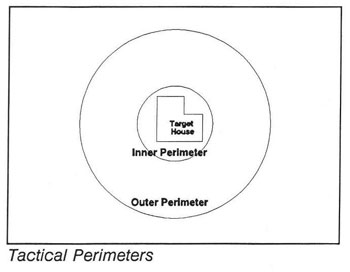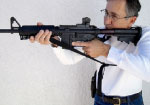
Phase ll - Incident
The second phase of a "Crisis Management" plan is an incident taking place that will call into play the plan. The plan that is in place should be sufficiently flexible to allow for the relatively small incident to the large incident. The size of the incident is measured by the number of different resources that have to be coordinated to resolve it. In the lone barricaded mentally disturbed suspect there might be as few as three different resources to manage. Typically these will be the patrol forces, hostage negotiators and tactical unit. In a larger incident such as the takeover of a public building by a terrorist group you may have many other resources to coordinate. These resources will come from all parts of government and all parts of your own agency.
There may be two or three tactical units from different agencies, hostage negotiators, politicians, press, reserves, and patrol from many different agencies, utility companies, and telephone companies. The list can go on and on.
Phase lll - Initial Response
The initial response to an incident should be a coordinated response. This can only take place if the initial units have some forewarning about what they are responding to. With the proper training of patrol forces, injury and death may be severely limited. If the patrol units have no forewarning of the type of incident that they are responding to, the possibility of death or injury to the initial units increases dramatically. lf the initial problem involves gunfire the first order of business is to take cover. Protective cover, that which will stop bullets, is the most desirable. lf cover is not available concealment is the next choice. Once the initial units have protected themselves, they should apply the rule of "ates". This rule states the initial units should:
1. Isolate
2. Communicate
3. Coordinate
4. Evacuate
5. Terminate
Each responding unit should have regular training in handling "Crisis Management" type incidents. They should be familiar with what is involved in the resolution of a crisis and have a guide which they can follow to help get them through the incident safely. Regardless of the type of problem, law enforcement must seize control of the threat environment to optimize their effectiveness. lf this is not done the suspect(s) will continue to control the situation endangering the lives of the law enforcement officers and civilians.
Phase lV - Organization of Resources
The law enforcement manager or the crisis response team is never the first to arrive at an incident. lf the first responding units have done their job the suspect(s) is isolated or contained in one area. This allows for the "Crisis Management" team to begin their work. The supervisor of the initial responding units will need to organize the first resources. The first resources needed will be enough uniform personnel to begin setting up a large (outer) containment area and a smaller (inner) containment area.
It is important at this point to gather as many resources as needed, as rapidly as possible, to keep containment. Some form of list or checklist should be available for the not only the initial responding supervisor, but for the communications center personnel. A checklist should ease some of the tension the supervisor is experiencing. The list may also help the supervisor recall an important resource.
Tactical Perimeters
After the arrival of support personnel a more detailed analysis of the situation can be made. The first requirement is to analyze the situation and assess the threat\risk. This is used to establish a foundation upon which strategy and tactics can be based. In assessing the threat\risk, at a minimum, the following variables should be examined:
1. Location (suspect/hostage environment)
2. Suspects (number, motivation, propensity to violence)
3. Weapons (number, type, level of sophistication)
4. Hostages (number, location, background, prominence)
5. Demands (extrinsic or monetary, escape or political)
A useful tool here is to have a Tactical Operations Center (TOC) established. The Law Enforcement Incident Command System (LEICS) is useful if implemented at this stage of an incident.





